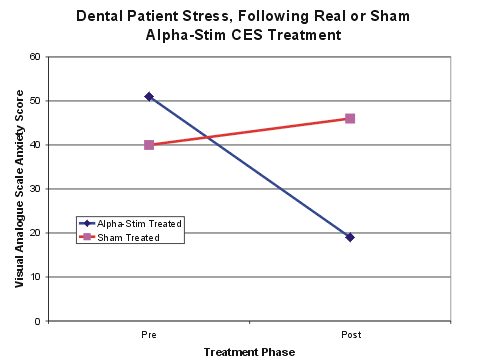Winick, Reid L. Cranial electrotherapy stimulation (CES): a safe and effective low cost means of anxiety control in a dental practice. General Dentistry, 47(1):50-55,1999.
This is a double-blind study of situational anxiety of 33 dental patients (9 males and 24 females, 20 to >59 years old). All patients completed informed consent. Patients were randomly assigned to an active Alpha-Stim CES group (N = 16), or sham CES (N = 17) in the order they arrived for various dental procedures. All subjects completed the study. A double-blinding box was used so neither the patient nor the dentist was aware who was receiving actual stimulation. 100 mm Visual Analogue Scales (VAS) of “not anxious” on the left to “very anxious” on the right were employed before, half way through, and after various dental procedures by both the patient and dentist, and a 7 point Likert scale was used at the conclusion of each treatment. There was no significant difference in anxiety levels before the procedure between both groups. However, the anxiety level after the procedure was significantly lower in the treatment group than the sham treatment group.
Statistics were performed by the student’s t-test (unpaired) comparing the active and sham groups at specific time points. The results are considered statistically significant at p<.05. The mean value for the dentist’s and subjects’ evaluations tended to be higher in the treatment group at the start probably due to the more severe procedures in that group compared to the sham group. Nevertheless, the overall feelings of anxiety were decidedly less in the treatment group when considering both the differences found in the dentist’s and subjects’ evaluations: for the dentist, treatment assessment by the VAS was -24 ± 6.4 (SEM) and for sham was -7.2 ± 3.2 (SEM) (p<.02). The difference was even seen at the midpoint where the mean change was -13.5 ± 5.0 (SEM) for treatment and -3.4 ± 2.9 (SEM) for sham (p<.04). At the end of the study, the subject’s evaluation by the VAS simulated the dentist’s evaluation: differences were -30.1 ± 9.0 (SEM) for treatment and -4.2 ± 3.9 (SEM) for sham (p<.02). However, no statistically significant differences were seen at the midpoint of the subjects’ evaluations: -5.6 ± 9.7 (SEM) for treatment and -2.8 ± 3.2 (SEM) for sham. The use of the Likert scale corroborated these findings. The treatment group was less anxious as indicated by an increase in the scale values in both the dentist and subject evaluations: dentist, 4.4 ± 0.4 (SEM) for treatment versus 2.3 ± 0.1 (SEM) for sham (p<.01); subjects, 4.8 ± 0.4 (SEM) for treatment versus 2.5 ± 0.3 (SEM) for sham (p<.01).
The author concluded that dental patients who experience extreme levels of anxiety are significantly comforted by using CES during various dental procedures. Many members of the treatment group requested CES at subsequent visits, and none objected to it. The low cost, safety, and ease of use of CES recommends its freer trial to enhance patient comfort during various routine dental procedures. There was no detectable adverse effects noted in any of the subjects.
|
